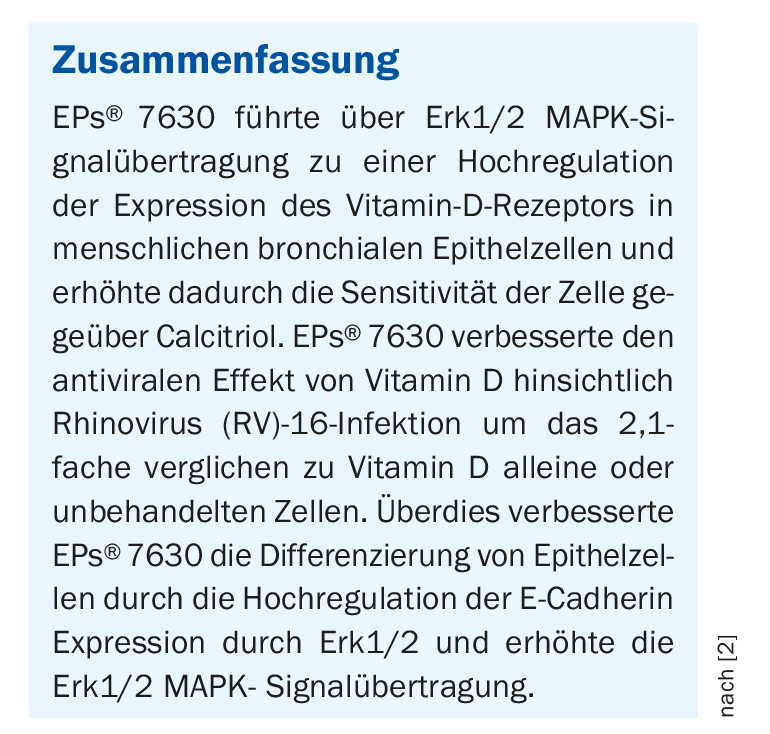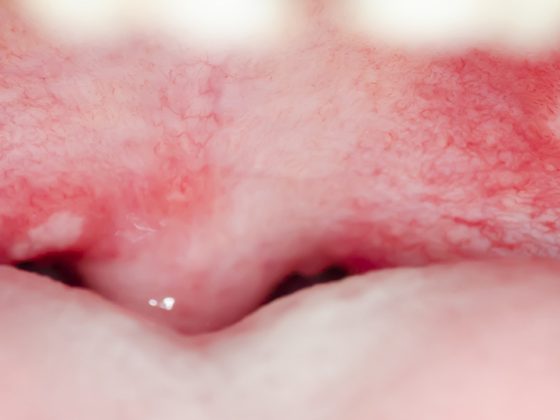That standardized extracts from roots of Pelargonium sidoides are effective against respiratory tract infections has been empirically proven several times. At the cellular level, it has now been shown that immune defense against rhinoviruses is increased by inducing upregulation of the vitamin D receptor in human bronchial epithelial cells.
EPs® 7630 is a standardized extract derived from the root of Pelargonium sidoides that has been shown to reduce the severity of viral upper respiratory tract infections. Vitamin D also improves antiviral defenses, in part through similar signaling pathways. Calcitriol, the biologically active form of vitamin D, is transported to target cells where its action is mediated by the vitamin D receptor [1]. The present study investigated whether EPs® 7630 modifies vitamin D receptor expression and function in relevant cells [2].
EPs® 7630 increases vitamin D receptor expression in bronchial tissue
Bronchial epithelial cells were incubated with EPs® 7630 for the period of 48 h before calcitriol stimulation and/or infection with rhinovirus (RV)-16. Protein expression was determined by Western blot analysis. Intracellular signaling of mitogen-activated pro-tein kinase (MAPK) was studied using chemical inhibitors. The antiviral effect was assessed by immunofluorescence for RV-16 protein.
Epithelial cells treated with EPs® 7630 increased vitamin D receptor expression in a concentration-dependent manner. The difference from non-treated cells was found to be significant at concentrations >5 μg/mL EPs® 7630 after 24 h. Based on previous observations, the involvement of MAPKs in EPs® 7630-mediated activation of vitamin D receptor expression was investigated. Erk1/2 MAPK proved to be the major regulatory signaling protein for EPs® 7630-induced expression of the vitamin D receptor. This effect is possibly due to the proanthocyanidins contained in EPs® 7630 [3].
By blocking the MAPK signaling pathway with specific chemical inhibitors, the stimulatory effect of EPs® 7630 (10 μg/mL) on vitamin D receptor expression decreased in a concentration-dependent and significant manner. In contrast, neither inhibition of p38 MAPK, nor that of Jun N-terminal kinase (JNK) by SP600125 had any significant effect on EPs® 7630-induced expression of vitamin D receptor.
Combination of EPs® 7630 and calcitriol increases defense against rhinoviruses
EPs® 7630 not only increased the expression of the vitamin D receptor overall, but also induced its translocation into the nucleus. Calcitriol significantly increased the number of cells with nuclear vitamin D receptor, this effect was increased by additional treatment of cells with EPs® 7630 (10 μg/mL). In a previous study, EPs® 7630 reduced epithelial cell infections caused by RV-16 [4]. This observation was confirmed by cell counting of RV-positive strains of undifferentiated bronchial epithelial cells (BEAS-2-B). Calcitriol alone also resulted in decreased RV infection of BEAS-2B cells in a concentration-dependent manner. The combination of inhibitory effects of EPs® 7630 and calcitriol with respect to RV-16 infections was significantly better compared to calcitriol alone. This effect proved to be additive rather than synergistic.
What is the role of E-cadherin expression?
EPs® 7630 increased the expression of E-cadherin in BEAS-2-B in a concentration-dependent manner over 24 h through activation of Erk1/2 MAPK. This is consistent with previous observations of EPs® 7630-induced activation of Erk1/2 MAPK in other cell types [5]. Consistent with these results, the expression of E-cadherin in a human bronchial epithelial cell line was suppressed by RV infection and resulted in epithelial-mesenchymal transition [6]. This mechanism is thought to contribute to the basement membrane thickening typical of asthma. There is also a correlation between vitamin D receptor expression and E-cadherin expression. In human bronchial epithelial cells, vitamin D increased the expression of E-cadherin and thereby induced cell differentiation [7].

Improved differentiation of epithelial cells
The increased expression of the vitamin D receptor by EPs® 7630 may also be involved in the enhanced differentiation of epithelial cells by increasing their barrier function and immune defense mechanisms. This fits with previous findings that low vitamin D levels are associated with an increase in epithelial differentiation and remodeling in COPD patients [8].
Conclusion and Aubslick
In summary, an increase in E-cadherin expression indicates that EPs® 7630 may reduce airway wall thickening during airway infection or inflammation. The upregulation of the vitamin D receptor and the enhanced response to vitamin D in EPs® 7630 treated cells supports the antiviral effect. Further studies are needed to confirm this, the authors said.
Literature:
- Baker AR, et al: Proc Natl Acad Sci U S A 1988; 85: 3294-3298.
- Roth M, Sun Q, Tamm M: Pharmaceuticals 2021; 14: 172.
- Wei J, et al: Int J Mol Med 2018; 41: 1608-1618,
- Roth, M, et al: PLoS ONE 2019, 14, e0210702.
- Witte K, et al: PLoS ONE 2015, 10, e0138075.
- Faris AN, et al: Am J Respir Cell Mol Biol 2016; 55: 487-499.
- Sari E, et al: J Steroid BioChem Mol Biol 2020; 202: 105723.
- Fei J, et al: J Immunol 2019; 203, 1428-1435.
HAUSARZT PRAXIS 2021; 16(9): 45











